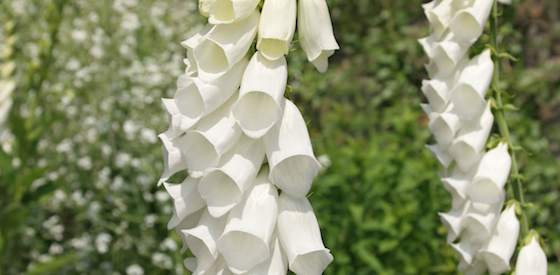By Sean Conway

August is time to start certain plants from seed, including biennials such as foxglove
For many gardeners, August is a tough time. Temperatures usually hit an annual high, rain is infrequent, and daylight begins to shorten. While some may throw in the towel (or trowel, as it were), those of us who have been at it for a while know that this is the time to start sowing seeds for cool-weather crops.
Vegetables that grow best in cool temperatures, such as broccoli, kale and lettuce, can be sown this month so they will be ready to transplant into the garden when temperatures cool down in several weeks. Many gardeners fail to take advantage of a second season in the garden, and that's a shame. Many cool weather crops can be harvested right up until a hard frost.
In my zone 6 garden, spring often progresses rapidly, and cool temperatures are usually short-lived. The opposite, however, is true during the fall months. Evenings begin cooling down as soon as mid- to late August, with daytime temperatures moderating about the same time.
By mid- to late August, many vegetables that have been happily growing during the heat of summer begin to slow down and the garden starts looking tired. Rather than leave struggling warm-loving plants such as zucchini, summer squash ,cucumbers or beans growing, I relegate them to the compost pile once their production slows.
I recondition my garden soil by adding compost and well-rotted manure. I usually check DIY stores and garden centers for late-summer sales on bagged manure, which is a convenient and cost-effective way to add nutrients back into your soil.
I find some cool-loving vegetable crops are best sown directly into the ground. Once I have prepared the soil, I sow crops like spinach, beets, radishes and some varieties of lettuce directly into the soil.
Larger vegetables like broccoli and kale are sown in flats and transplanted with adequate spacing into rows once they have achieved some size.
Vegetables are not the only plants that should be sown in August. Biannual plants should be started from seed now too. Biannual plants, unlike annuals, stay alive through their first winter, bloom the following spring, set seed then die. Seed germinated now allows the plants plenty of time to grow before winter arrives, and ensures large, healthy plants for next spring.
Several years ago, I purchased seed in England of a pure white, unspotted foxglove with exceptionally tall flower stalks. Foxgloves are perfect examples of biennials, and this variety is a showstopper each spring in my woodland garden. After the flowers fade, the plants set seed in August. I collect it, germinate it, and plant out several dozen plants by mid fall. The plants go dormant over the winter, and I almost forget they are there until the following spring when the white spires return to light up the garden.
Biannual plants are often not available in garden centers because of their growth cycles; there are fewer customers around in the fall to purchase them, so they are seldom grown.
These plants are best ordered as seed from catalogs, and their minimal maintenance requirements are well worth the effort.
If the August heat has you sitting in the shade, don't give up on your garden, start planning ahead and sow some seeds for the future.
Available at Amazon.com:
Cut Your Energy Bills Now: 150 Smart Ways to Save Money & Make Your Home More Comfortable & Green
It's Easy Being Green: A Handbook for Earth-Friendly Living
Sean Conway's Cultivating Life: 125 Projects for Backyard Living
© SEAN CONWAY. DISTRIBUTED BY Tribune Media Services
AUTOS | HOBBIES | EDUCATION | FAMILY | FASHION | FOOD & RECIPES | HOME DECOR | RELATIONSHIPS | PARENTING | PETS | TRAVEL | WOMEN
Home & Garden - Dog Days of August: Time to Think of Planting for Fall